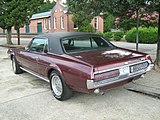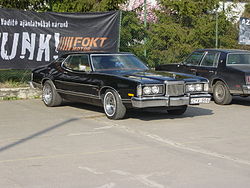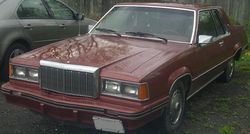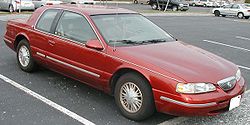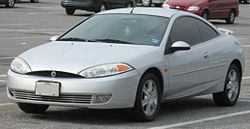Mercury Cougar
| Mercury Cougar | |
|---|---|
| Production period: | 1966-2002 |
| Class : | Middle class / upper middle class |
| Body versions : | Sedan , station wagon , coupe , Combi Coupé , Cabriolet |
| Successor: | Mercury Marquis |
The Mercury Cougar was a car manufactured in North America by Mercury , a brand of Ford Motor Company , from the fall of 1967 to the summer of 2002 . During this time there were a number of model generations belonging to different market segments. The name is derived from the cougar , the puma native to North, Central and South America, also mountain lion. Exit Cougar .
The model name Cougar, which had achieved a certain level of establishment through the first model and was a counterpart to the Ford Mustang , became the subject of a badge shifting process in the 1970s and 1980s . H. the transfer of a model name to vehicles of different classes. After initially being a sports car, the Cougar was a mid-range sedan produced in two generations from 1976 to 1982 and, as the Mercury Cougar XR-7, was a luxury coupé that was a counterpart to the Ford Thunderbird until the 1990s . From 1998 to 2002, a somewhat smaller coupé based on the Mercury Mystique or the Ford Contour was called the Ford Cougar on the European market .
1st generation Cougar (1967–1968)
| First generation | |
|---|---|
|
Mercury Cougar (1967-1968) |
|
| Production period: | 1967-1968 |
| Body versions : | Coupe |
| Engines: |
Gasoline engines : 4.7–7.0 liters (149–279 kW) |
| Length: | 4830 mm |
| Width: | 1811 mm |
| Height: | 1313 mm |
| Wheelbase : | 2819 mm |
| Empty weight : | 1500 kg |
The Ford Mustang, introduced in 1964, was a sales success that showed how significant the market opportunities for sporty cars were in America. General Motors , the largest American car company, had initially overlooked this trend and it took two and a half years before it was able to present the Chevrolet Camaro as a competitor model in the fall of 1966 . Since it was foreseeable that the Camaro would reduce sales of the Mustang, Ford planned a step ahead and brought out the Mercury Cougar at the same time as the Camaro. This was designed as a more luxurious version of the Mustang for customers who wanted to drive a sporty car, but at the same time placed higher demands on comfort and exclusivity.
The Cougar was therefore only available with V8 engines from 4700 cm³ to 6400 cm³, while the Mustang was also available with six-cylinder engines. For the 1968 model year, the Cougar received minor changes (side indicators) and more powerful engines (from 5.8 to 7.0 liters displacement).
Quantity (model years):
- 1967: 150.893 (2-door hardtop (65A): 116.289; 2-door hardtop XR7 (65B): 27.209; 2-door hardtop (65C): 7.395)
- 1968: 113,726 (2-door hardtop (65A): 78,359; 2-door hardtop XR7 (65B): 32,709; 2-door hardtop (65C): 2,673)
Source: cougarclub.org
2nd generation Cougar (1969–1970)
With the second generation from 1969, the body grew significantly and the Cougar was also available as a convertible. The coke-bottle hip curve was much more distinctive and the wheelhouses were no longer round, following the wheel, but wider. The trim strips of the radiator grille including the hideaway headlights were made horizontally from 1969 and the taillights were revised. In 1970 the cougar received another facelift and the cougar face a more distinctive "nose". The Cougar was thus still competitive on the market.
Quantity (model years):
- 1969: 100.069 (2-door hardtop (65A): 64.735; 2-door hardtop XR7 (65B): 23.914; 2-door hardtop (65C): 1.616; 2-door convertible (76A): 5.706; 2-door convertible XR7 (76B): 4.024)
- 1970: 72,343 (2-door hardtop (65A): 49,479; 2-door hardtop XR7 (65B): 18,567; 2-door convertible (76A): 2,322; 2-door convertible XR7 (76B): 1,997)
Source: cougarclub.org
3rd generation Cougar (1971–1973)
| Second generation | |
|---|---|
|
Image does not exist Mercury Cougar (1969-1970) |
|
| Production period: | 1969-1970 |
| Body versions : | Coupé , convertible |
| Engines: |
Gasoline engines : 4.7–7.0 liters (149–279 kW) |
| Length: | 4923 mm |
| Width: | 1905 mm |
| Height: | 1318 mm |
| Wheelbase : | 2819 mm |
| Empty weight : | 1603 kg |
In the autumn of 1970 the Cougar received a completely new body over 5 meters in length for the 1971 model year and was still available as a coupé and convertible. The conception of the Cougar proved to be successful, also in terms of sales figures. However, General Motors brought out the Pontiac Firebird as early as the spring of 1967 , which in the General Motors model range for the Chevrolet Camaro was similar to the Cougar for the Mustang.
From 1970, the sales of the Ford Mustang fell as the pony cars became generally less attractive. The cougar was also affected. In 1973 the Mustang was discontinued in its previous form and replaced by the much smaller Mustang II model. The Cougar also had to be redefined in the Mercury model range.
Quantity (model years):
- 1971: 62.864 (2-door hardtop (65D): 34.008; 2-door hardtop XR7 (65F): 25.417; 2-door convertible (76D): 1.722; 2-door convertible XR7 (76F): 1.717)
- 1972: 53,702 (2-door hardtop (65D): 23,731; 2-door hardtop XR7 (65F): 26,802; 2-door convertible (76D): 1,240; 2-door convertible XR7 (76F): 1,929)
- 1973: 60.629 (2-door hardtop (65D): 21.069; 2-door hardtop XR7 (65F): 35.110; 2-door convertible (76D): 1.284; 2-door convertible XR7 (76F): 3.166)
Source: cougarclub.org
4th generation Cougar XR-7 (1974-1976)
| Second generation | |
|---|---|
|
Mercury Cougar |
|
| Production period: | 1974-1976 |
| Body versions : | Coupe |
| Engines: |
Petrol engines : 5.8–7.5 liters (149–279 kW) |
| Length: | 5441 mm |
| Width: | 1994 mm |
| Height: | 1336 mm |
| Wheelbase : | 2896 mm |
| Empty weight : | 1538-1928 kg |
Mercury did not follow the downsizing of the Mustang. The Mercury Division therefore no longer offered its own version of the Mustang II from 1974; The role of the Mustang counterpart was taken over by the Mercury Capri , an Americanized version of the Ford Capri II made in Germany .
The Cougar was repositioned for the 1974 model year. Instead of the previous sporty coupé, the Cougar has now become a model in the Personal Luxury Class , with the emphasis on comfort.
At the same time, the model name changed, because from 1974 to 1976 the vehicles were all called the Cougar XR-7 . The term XR-7 , which in the previous years had only referred to a certain equipment variant, thus became an integral part of the model name.
From a technical point of view, the Cougar XR-7 was closely related to the mid-range models of the Ford group from 1974. It was now based on the Montego coupe, which in turn was the Mercury version of the Ford Torino . His parallel model at Ford was the Ford Elite . The competition from General Motors now formed the models Chevrolet Monte Carlo and Pontiac Grand Prix , and he also competed against the Chrysler Cordoba and its twin Dodge Charger SE .
The Cougar was presented shortly before the outbreak of the first oil crisis . Regardless of the resulting shortage of petrol and the emerging interest of American buyers in small, fuel-efficient models, the large and heavy Cougar of this model generation achieved impressive sales figures, while the small Mustang II had not met the taste of the American public.
A total of 299,050 pieces of this generation's Cougar were produced.
From the 1977 model year, the model name Cougar was transferred to Mercury's middle class, which had previously been called the Montego. So there were sedans, coupes and station wagons from the new Cougar. The role of the previous Cougar as an exclusive luxury coupé was taken over by the Mercury Cougar XR-7 from 1977 . It was Mercury's counterpart to the Ford Thunderbird from 1977 to 1982.
5th generation Cougar (1976–1979)
| Third generation | |
|---|---|
|
Mercury Cougar (1976-1979) |
|
| Production period: | 1976-1979 |
| Body versions : | Sedan , station wagon , coupé |
| Engines: |
Gasoline engines : 4.9–6.6 liters (97–129 kW) |
| Length: | 5474-5575 mm |
| Width: | 1981 mm |
| Height: | 1336-1445 mm |
| Wheelbase : | 2896 mm |
| Empty weight : | 1704-2009 kg |
With the model change that took place in the fall of 1976, the Ford mid-range cars not only received new bodies, the model names were also mixed up a lot. The Ford Torino became the LTD II ; the Thunderbird has been reduced in size considerably, making the elite obsolete.
At Mercury the name "Montego" was given up. The whole series was now called the Cougar , so in addition to the coupe, the sedan and the station wagon as well. The previous Cougar, the luxurious coupé variant, was called the Cougar XR-7 from model year 1977 .
The third series of the Cougar was a stylistically slightly revised version of the Ford LTD II . Technology, drive and body concept corresponded to the LTD II, only the front and rear sections had been redesigned. The Cougar had four rectangular headlights arranged side by side, while the lights of the LTD II were vertically one above the other. Contrary to the usual practice of the 1970s, the Cougar had not been reduced in size compared to its predecessor Montego, the car was still well over 5 meters long and only had eight-cylinder engines with a displacement of at least 4942 cm³.
There was criticism of the size of the car that it was no longer up to date. Nevertheless, the Cougar sold in considerable numbers. However, this series was only built for three years. After that, the trend towards downsizing American cars could not be stopped.
The station wagon version with the designation Cougar Villager was only produced in model year 1977. In contrast to the sedan and coupé, the station wagon had a hip swing that stretched from the rear door to the rear side window. This feature also had the LTD II station wagons of the sister brand Ford. It was adopted unchanged from the previous model, the Ford Torino station wagon. Like all other models, the Villager was also available in various equipment versions, including a Brougham. The standard engine was a 5.8 liter (351 cubic inch) eight-cylinder engine with twin carburetors; a 6.6 liter (400 cubic inch) version was available as an option. The production of the Villager was only 8569 pieces. The price was slightly higher than the sedan version and was $ 5363.
A total of 554,907 units of this Cougar model generation were produced, 455,023 of which were XR-7s.
6th generation Cougar (1979–1982)
| Fourth generation | |
|---|---|
|
Mercury Cougar Coupé (1979–1982) |
|
| Production period: | 1979-1982 |
| Body versions : | Sedan , station wagon , coupé |
| Engines: |
Gasoline engines : 2.3-4.9 liters (65-97 kW) |
| Length: | 4999-5090 mm |
| Width: | 1803-1882 mm |
| Height: | 1346-1379 mm |
| Wheelbase : | |
| Empty weight : | 1330-1494 kg |
At the end of 1979 the Ford LTD II and the Cougar sedan were given up without replacement. Only the Thunderbird and the Cougar Coupé received a model change. The new model was significantly reduced in size and was based on the Ford Fairmont , which served the lower middle class in the American Ford model range.
The body was angular and not very spectacular, the engines disappointingly inefficient. There were still V8 engines with a displacement of 4200 and 5000 cm³, but these had a maximum output of 110 kW (150 hp). Among them there was an old-fashioned six-cylinder in-line engine taken over from the Fairmont, which got 66 kW (90 hp) out of 3300 cc.
This series could not inspire the previous customers of Thunderbird and Cougar. Declining sales figures were the result.
In 1980 the range was again expanded to include a sedan and a station wagon. These were the Mercury version of the American Ford Granada of the second generation, the successor to the previous Mercury Monarch . This model offered the first four-cylinder engine that was ever offered in a Cougar. It was the 2300 cm³ "Pinto" engine that was also installed in the Taunus and Granada models in Europe .
The Cougar sedan was also not a sales success. In 1982 this series, which represents a low point in the history of the Cougar, was discontinued.
Of the Cougar, which was downsized for the first time, 169,120 units were built in three years, 112,170 of which were XR-7s.
7th generation Cougar (1983–1988)
| Fifth generation | |
|---|---|
|
Mercury Cougar (1985-1986) |
|
| Production period: | 1983-1988 |
| Body versions : | Coupe |
| Engines: |
Petrol engines : 2.3–4.9 liters (82–115 kW) |
| Length: | 5100 mm |
| Width: | 1806 mm |
| Height: | 1367 mm |
| Wheelbase : | 2640 mm |
| Empty weight : | 1314-1579 kg |
The Cougar was repositioned for the 1983 model year. Now the series no longer covered the mid-range sedan market, but was upgraded. In the future, the Mercury version of the new Ford Thunderbird was sold under the name Cougar , which was also technically similar to the Lincoln Continental Mark VII .
The Cougar appeared in February 1983. Like the Thunderbird, it was based on the so-called Fox platform with rear-wheel drive introduced in 1977 with the Ford Fairmont , but its body differed considerably from the Thunderbird. The main distinguishing feature was a different front section and a roof with a wide, steep C-pillar , known as the "Formal Roof".
The Cougar, available as a basic model and as a more extensively equipped LS model, was powered by a 3.8-liter V6 or an injected 4.9-liter V8 and, in terms of numbers, proved to be much more successful than its direct predecessor. From model year 1984 the Cougar was also available with a turbocharged 2.3-liter four-cylinder. In 1985 there was a small facelift with a new, Mercedes- like radiator grille.
In the autumn of 1986, another facelift took place for the 1987 model year, which was recognizable by the newly modified grill and the headlights that were flush with the body. At the same time, the turbo engine was omitted. In 1988 the V6 received a balance shaft and more power.
683,804 units of this generation's Cougar were sold in just under six years.
8th generation Cougar (1988–1997)
| Sixth generation | |
|---|---|
|
Mercury Cougar (1996-1997) |
|
| Production period: | 1988-1997 |
| Body versions : | Coupe |
| Engines: |
Petrol engines : 3.8–4.9 liters (104–153 kW) |
| Length: | 5047 mm |
| Width: | 1847 mm |
| Height: | 1339 mm |
| Wheelbase : | 2870 mm |
| Empty weight : | 1501-1721 kg |
At the end of 1988, Mercury launched a completely new rear-wheel drive Cougar in parallel with the new Ford Thunderbird .
The wheelbase grew by a good 20 cm, while the length was a few centimeters shorter. The design was more conventional than its predecessor with less steep C-pillars and the absence of the raised rear side windows. The drive was taken over by the 3.8-liter V6 known from its predecessor, which was available in a naturally aspirated version and now as a supercharger version, while the V8 was no longer available. A minor facelift followed for the 1991 model year and the supercharged V6 was replaced by a high-performance variant of the 4.9-liter V8.
From 1994, a version of the new “modular” 4.6-liter V8 was used instead of the 4.9-liter. In mid-1996 the last little facelift followed with a smaller grille and detail retouching.
By the time production was discontinued in the summer of 1997, 561,838 of this generation of Cougars had been made.
Personal luxury cars went out of fashion in the 1990s . Sales fell and one model after another was discontinued. Because of the reduced market opportunities, the Cougar and the Thunderbird were abandoned in 1997. The luxurious Lincoln Mark VIII was built a year longer. The Ford Motor Company has not offered a large coupe since 1998.
9th generation Cougar (1998-2002)
| Seventh generation (data for US version) | |
|---|---|
|
Mercury Cougar (1998-2002) |
|
| Production period: | 1998-2002 |
| Body versions : | Combi coupe |
| Engines: |
Petrol engines : 2.0–2.5 liters (93–126 kW) |
| Length: | 4699 mm |
| Width: | 1768 mm |
| Height: | 1326 mm |
| Wheelbase : | 2703 mm |
| Empty weight : | 1311 kg |
In mid-1998, based on the Mercury Mystique, a completely new Cougar sports coupé with front-wheel drive in the so-called New Edge design appeared. This much smaller and lighter vehicle was offered in Europe as the Ford Cougar . The car was powered either by a two-liter four-cylinder or a 2.5-liter V6 with 24 valves.
See also
literature
- Gunnell, John: Standard Catalog of American Cars 1946-1975 . Krause Publications, Iola 2002. ISBN 0-87349-461-X , pp. 529-547.
- Flammang, James M. and Kowalke, Ron: Standard Catalog of American Cars 1976-1999 . Krause Publications, Iola 1999. ISBN 0-87341-755-0 , pp. 627-697.
- Don Skinner, The Big Book Mercury Cougar The Classic Years 1967 ~ 1973, ISBN 1-4995-0946-4 .
Web links
- Cougar Club of Germany - Cougar owners Club
- Cougar Club of America
Individual evidence
- ↑ a b c 1967-1973 Cougar Production ( English ) cougarclub.org. Retrieved September 9, 2019.
- ↑ Langworth: Encyclopedia of American Cars 1930–1980, p. 464 f.


